Euroleague Positional Statistics (II) – Power Forwards
In part two of our midseason mini series, we are looking at the statistical performance of power forwards in the 2011/12 Euroleague season.
For a short introduction I point you to the opening post. The glossary should also provide help.
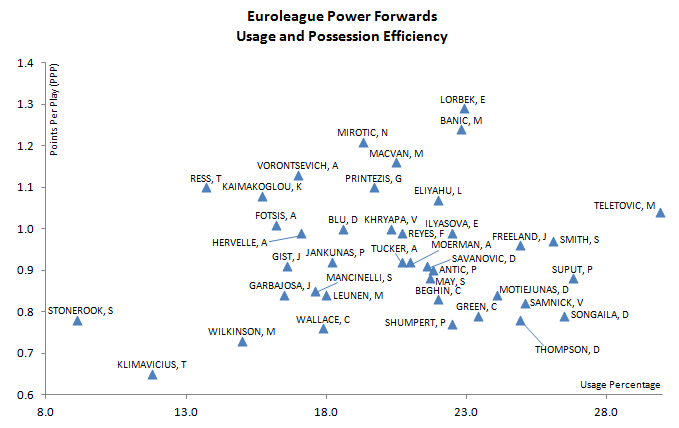
Erazem Lorbek must be among the MVP candidates based on his Euroleague play. Lorbek is scoring the basketball with ridiculous efficiency and not committing turnovers, but that is only the Euroleague Lorbek. The ACB Lorbek is scoring the basketball on 0.919 PPP. Say hello to our sample size problem.
If the small forward position is somewhat short of talent, the power forward position is not. Most of the top players are in their mid to late twenties, but Mirotic (’91), Macvan (’89) and Motiejunas (’90) have to be considered elite level based on their play this season.
Always keep an eye on the top left in usage vs efficiency charts: low-usage, functional role players who do their job. Guys like Kaimakoglou, Vorontsevich, Ress.
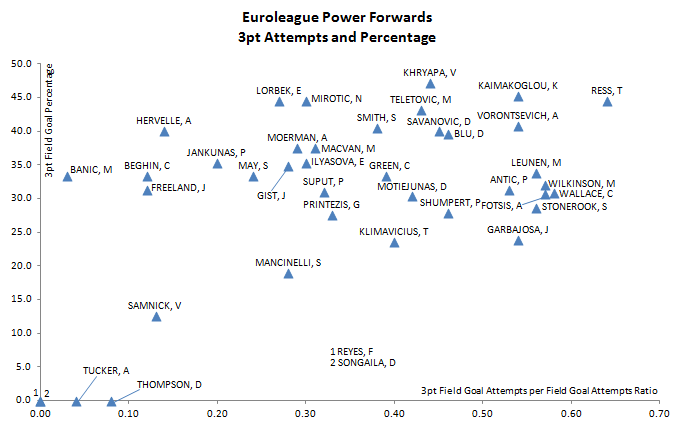
The three point shot is almost a necessity in a modern power forward’s game. Only few power forwards play exclusively inside the arc these days. Among players with a total of 150 minutes or more, only five (Reyes, Tucker, Thompson, Banic, Songaila) take less than ten percent of their shots from the outside. There is a crop of hybrid PFs who can play different roles based on team strategy, including usage at the center position. If you ask Freeland or Lorbek to play a strict stretch four, they’ll play the stretch four, but they are both capable of plenty of inside scoring.
The advantage of using a stretch four is obvious: You create space for whatever your high percentage weapons are, usually the 1/5 pick and roll. Coaches preach floor spacing religiously. That is why you see a high amount of power forward three point shots.
I did not add info on assisted/unassisted three point shots since the overwhelming majority of power forward three pointers is created by an assist. There is exactly one prominent exception: Mirza Teletovic, who shoots like a guard in both dimensions – frequency, unassisted/assisted ratio. The most similar player in terms of unassisted/assisted shots per minute is Henry Domercant. No need to say more.
There are power forwards who score from two point range. Alongside mentioned Lorbek and Freeland, Eliyahu, Samnick, Macvan, Tucker, Suput, Songaila score more than 2.5 unassisted two pointers per 28 minutes. Tucker, a 3/4, usually attacks his man facing the basket, Eliyahu is simply unorthodox with his arsenal of floaters and runners. Songaila is scoring on 45.5 percent from two point range, Lorbek (the Euroleague version) 66.3.
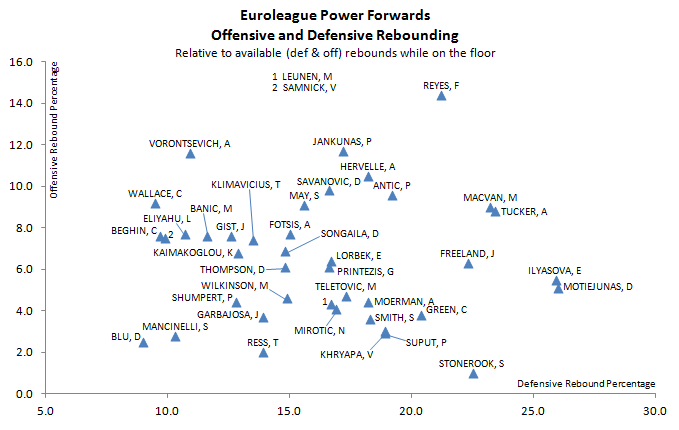
Reyes has been among the competition’s best offensive rebounders for years. Real possesses one of the more interesting Euroleague frontcourts: Mirotic and Reyes are fundamentally different players. Laso obviously doesn’t like the Reyes/Tomic combo (40 minutes this season), but he does like Mirotic/Tomic (134) and Reyes/Begic (90). Mirotic/Begic (65) comes third, Mirotic with Reyes at center (57) fourth.
Blu offers great shooting at the four, but he also brings subpar rebounding. Sofo is not doing the job either and Hendrix is an average defensive rebounder, but Maccabi is still above league average in defensive rebounding.
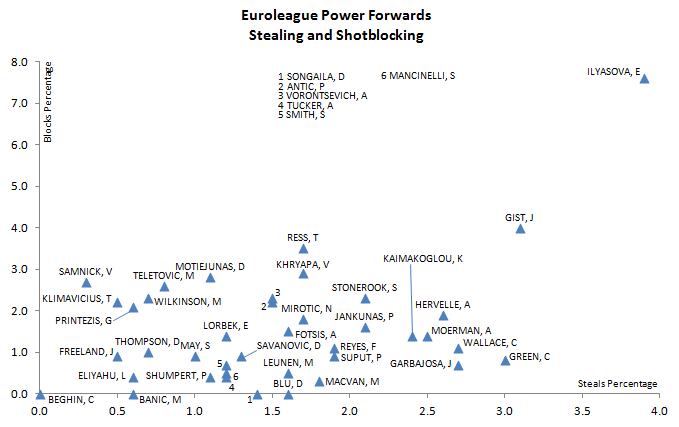
Steals and blocks only cover a small portion of defensive performance. Would you call Gist a good defensive player? I doubt. But they are still measurable contributions.
The performance of Ilyasova, who is excellent in steals, blocks and defensive rebounds, stands out here. You get a sense of what Efes is missing.
Christophe Beghin has managed to go without a single steal or block in 168 minutes.
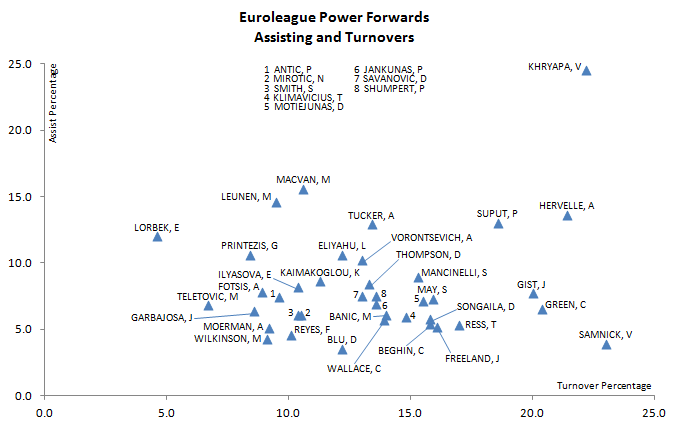
Khryapa’s passing is off the charts. He’s also committing a fair amount of turnovers, but they’ll take that as long as he creates easy looks for Krstic, Kirilenko etc. And he does that. Here’s the thing about turnover percentage: It punishes players who don’t take shots. Khryapa averages just 6.5 shot attempts a game, but he takes risks with his passing. TOV% is in the “per possession”-family, like PPP.
Lorbek’s is committing no turnovers (yes, in ACB, too), that is, combined with the number of shots he creates for himself, remarkable.
Edit: Table attached
(SC/G = shots created = (unassisted field goals + assists) / game ; ASST’D% = assisted field goals / field goals * 100
[table id=29 /]
Minimum: 150 minutes
¹ USG% = 100 * ((FGA + 0.47 * FTA + TO) * (Tm MP / 5)) / (MP * (Tm FGA + 0.47 * Tm FTA + Tm TO))
² PPP = Pts / ((FGA + 0.47 * FTA + TO)
³ ORB% = 100 * (ORB * (Tm MP / 5)) / (MP * (Tm ORB + Opp DRB)); DRB% = 100 * (DRB * (Tm MP / 5)) / (MP * (Tm DRB + Opp ORB))
⁴ STL% = 100 * (STL * (Tm MP / 5)) / (MP * Opp Poss)
⁵ BLK% = 100 * (BLK * (Tm MP / 5)) / (MP * (Opp FGA – Opp 3PA))
⁶ AST% = 100 * AST / (((MP / (Tm MP / 5)) * Tm FG) – FG)
⁷ TOV% = 100 * TO / (FGA + 0.47 * FTA + TO)
-
Dimitris Ritsonis
-
http://www.in-the-game.org sJacas
-
Dimitris Ritsonis
-
http://www.in-the-game.org sJacas